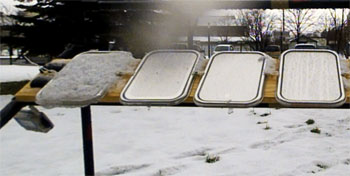Goo-oozing deicer protects surfaces
New coatings inspired by common garden pests — slugs — offer hope for reducing frosty buildups

Ice- and-snow-covered road signs pose a safety hazard. But a new coating that oozes liquid-repelling substances may someday help prevent such an icy buildup.
stickasa/iStockphoto
By Sid Perkins
Ice and snow can cause big problems when they stick to surfaces in cold weather. These frosty materials can obscure road signs, for example. They can pile up to dangerous heights on roofs, adding tons of weight. Or, they can stick to aircraft wings and affect the amount of lift a plane can generate. Now, researchers have developed a coating that might fight icy buildups on a wide range of surfaces. The coating works unlike any other. And it was inspired by the slime-oozing habits of a common garden pest.
Maybe you’ve seen these slugs. They are invertebrates, which means they lack a backbone. Many look like snails without a shell. But just like snails, slugs tend to leave a trail of sticky slime wherever they travel. “Slugs are amazing,” says Chihiro Urata. He works at the National Institute of Advanced Industrial Science and Technology in Nagoya, Japan.
“Even though slugs are often covered with sticky slime, you never see one that’s covered with dirt,” Urata notes. That’s because the slime that oozes from the slug’s body constantly flushes away particles. That observation inspired Urata. He’s a materials scientist, someone who designs new materials or analyzes existing ones. Among other things, he studies how the structure, recipe and other aspects of a material can affect its useful traits.

They started by mixing this goo with other materials that turn into a gel. When painted onto a surface, the gel hardens into a clear flexible coating, explains Urata. In his team’s first attempts, the liquid-repelling materials oozed out constantly. And no surprise: The coating quickly ran dry and lost its liquid-repelling action.
Later, the team found a way to make the materials ooze out only when temps dip below the freezing point of water. That’s when surfaces also are most at risk of getting coated in ice or snow. As a bonus, the researchers found a way to make their liquid-repelling goo soak back into the coating when temperatures warm again. That means the coating might work quite a while before needing to be replaced.
In recent tests, the coating repelled ice and snow even after going through 10 cycles of freezing and rewarming. The researchers presented their findings in San Diego, Calif., on March 17 at the annual meeting of the American Chemical Society.
“This is a very interesting concept,” says Anish Tuteja. He’s a materials scientist at the University of Michigan in Ann Arbor. “This new approach to repelling ice and snow is very innovative.”
The big challenge, says Tuteja, is making coatings that can last a long time. To be useful, they’d need to last much longer than the 10 freeze/thaw cycles that Urata and his team have demonstrated. Such coatings also would need to be very durable for use on surfaces of things that move and carry people, he notes. That would include aircraft wings or car windshields. Perhaps researchers might embed ice-resisting goos inside tougher coatings, he says.
To be used on aircraft or vehicles, the coatings would need to pass many tests, says Urata. “But we believe that our coating will be used for such purposes in the future.”
The snow- and ice-repellent coatings could be adapted for other uses too. For instance, they could be painted onto the hulls of ships, Urata says. Here, the goal would be to keep barnacles and other marine life from attaching to the ship below the water level. Those creatures can slow the flow of water over a surface, creating drag (or friction). This can greatly slow down the vessel so that it has to use more fuel.
Another possible use: The coatings might be painted into the molds used to make machine parts in factories. Hot melted metal is poured into a mold. If the inside of that mold were first coated with the new material, the mold later could be twisted slightly to make the new metal parts pop out easily. It would allow those molds to work a bit like twisting a standard plastic ice-cube tray to pop out the small frozen blocks of ice.
Power Words
(for more about Power Words, click here)
deicer A substance used to remove ice from or prevent ice buildup on surfaces such as airplane wings or car windshields.
drag A slowing force exerted by air or other fluid surrounding a moving object.
friction The resistance that one surface or object encounters when moving over or through another material (such as a fluid or a gas). Friction generally causes a heating, which can damage the surface of the materials rubbing against one another.
gel A gooey or viscous material that can flow like a thick liquid.
innovation (v. to innovate; adj. innovative) An adaptation or improvement to an existing idea, process or product that is new, clever, more effective or more practical.
invertebrate An animal lacking a backbone. About 90 percent of animal species are invertebrates.
lift An upward force on an object. It may occur when an object (such as a balloon) is filled with a gas that weighs less than air; it can also result when a low-pressure area occurs above an object (such as an airplane wing).
marine Having to do with the ocean world or environment.
materials science The study of how the atomic and molecular structure of a material is related to its overall properties. Materials scientists can design new materials or analyze existing ones. Their analyses of a material’s overall properties (such as density, strength and melting point) can help engineers and other researchers select materials that best suited to a new application. People who work in this field are known as materials scientists.
particle A minute amount of something.
slug A soft-bodied invertebrate that travels by sliding across a surface of slime that its body releases. It resembles a snail without a shell.
This is one in a series presenting news on invention and innovation, made possible with generous support from the Lemelson Foundation.







